Belfast
| Belfast | |
| County Antrim | |
|---|---|
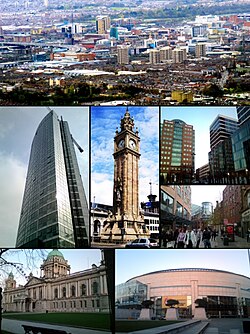
| |
| Location | |
| Location: | 54°35’49"N, 5°55’48"W |
| Data | |
| Post town: | Belfast |
| Postcode: | BT1–BT17, BT29 (part), BT36 (part), BT58 |
| Dialling code: | 028 |
| Local Government | |
| Council: | Belfast City Council |
| Parliamentary constituency: |
Belfast North, Belfast South, Belfast East Belfast West |
| Website: | www.belfastcity.gov.uk |
Belfast stands at the head of Belfast Lough. It is the county town of County Antrim and the capital and the largest city of Northern Ireland. It is a major urban and industrial centre.
The city of Belfast has a population of 267,500[1] and lies at the heart of the "Greater Belfast" urban area, which has a population of some 483,418. The Dublin-Belfast corridor is reckoned to hold a population of 3 million, or half the total population of the island of Ireland.
Belfast stands on the county boundary, marked by the River Lagan and spreads over both banks. Thus although the city centre is in Antrim, a great deal of it stands in Downshire also.
Historically, Belfast has been a centre for the linen industry (earning the nickname "Linenopolis"), tobacco production, rope-making and shipbuilding: the city's main shipbuilders, Harland and Wolff, (which built the ill-fated RMS Titanic) propelled Belfast on to the global stage in the early 20th century as the largest and most productive shipyard in the world. Belfast played a key role in the Industrial Revolution, establishing its place as a global industrial centre until the latter half of the 20th century.
Industrialisation and the inward migration it brought made Belfast the largest city in Ireland for a time at the turn of the 20th century and the city's industrial and economic success was cited by unionists as a reason why Ireland should shun Irish Home Rule and later why Ulster in particular would fight to resist it.
Belfast remains a centre for industry, arts, higher education and business, the legal and governmental centre of Ulster, and its economic engine.
The city suffered greatly during the Troubles, but latterly has undergone a sustained period of commercial growth since the political violence of former years has ended Belfast city centre in particular has undergone expansion and regeneration in recent years, notably around Victoria Square.
Two airports serve Belfast: George Best Belfast City Airport in the city, and Belfast International Airport 15 miles west of the city. It is also a major seaport, with commercial and industrial docks dominating the Belfast Lough shoreline, including the famous Harland and Wolff shipyard.
The city is also the seat of the devolved Northern Ireland Executive and Assembly.
Geography
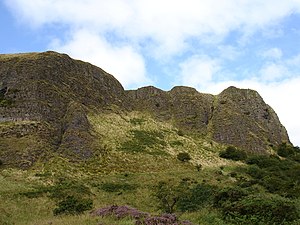
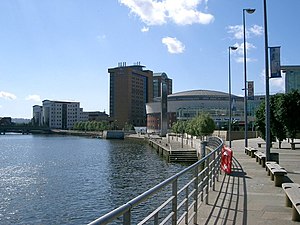
Belfast is on the east coast of Ulster, standing at the head of Belfast Lough and the mouth of the River Lagan, making it an ideal location for the shipbuilding industry that once made it famous. The city is hemmed in to the northwest by a series of hills, most prominent of which is Cavehill.
In 1994, a weir was built across the Lagan by the Laganside Corporation to raise the average water level so that it would cover the unseemly mud flats which gave Belfast its name[2] The River Farset is also named after this silt deposit, from the Irish feirste meaning "sand spit"). Originally a more significant river than it is today, the Farset formed a dock on High Street until the mid 19th century; Bank Street in the city centre referred to the river bank and Bridge Street to the site of an early Farset bridge.[3] The Farset is now a hidden river, conduited beneath the High Street.
Belfast's northern and north-western flanks are covered by a series of hills, including Divis Mountain, Black Mountain and Cavehill. Cavehill's looming bulk is thought have inspired Jonathan Swift writing Gulliver's Travels while living at the bottom of Limestone Road; Cavehill resembling the shape of a sleeping giant safeguarding the city.[4] The shape of the giant's nose, known locally as Napoleon's Nose, is officially called McArt's Fort probably named after Art O'Neill, a 16th century chieftain who controlled the area at that time.[5] To the southeast the Castlereagh Hills overlook the city.
Areas and districts
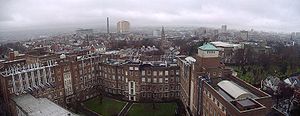
Belfast expanded very rapidly from being a market town to becoming an industrial city during the course of the 19th century. Because of this, it not so much an agglomeration of swollen villages as found in similar industrial cities such as Manchester or Birmingham but a single urban mass which subsumed its villages as it expanded to the barrier of the hills. Thus the arterial roads which carried this expansion (such as the Falls Road or the Newtownards Road) better define the city's parts The city may be reckoned in five areas; the City Centre, North Belfast, East Belfast, South Belfast and West Belfast, each of the latter a parliamentary constituency.
Belfast has also been divided by walls, commonly known as "peace lines", erected by the Army after August 1969 to keep warring communities apart. Some of the walls have been pulled down, but the others remain, to divide fourteen districts in the inner city.[6] In 2008 a process was proposed for the removal of the "peace lines".
Since 2001, boosted by increasing numbers of tourists, the city council has developed a number of cultural quarters:
- The Cathedral Quarter is the city's key cultural locality. It takes its name from St Anne's Cathedral (Church of Ireland) [7] It hosts a yearly visual and performing arts festival.
- The Gaeltacht Quarter around the Falls Road in West Belfast promotes and encourages the use of the Irish language.[8]
- The Queen's Quarter in South Belfast, named after Queen's University, has a large student population and hosts the annual "Belfast Festival at Queen's". Here are the Botanic Gardens and the Ulster Museum.
- The Golden Mile is the mile between Belfast City Hall and Queen's University, containing some of the best bars and restaurants in the city.[9] The nearby Lisburn Road has developed into the city's most exclusive shopping strip.
- The Titanic Quarter covers @0.75|km² of reclaimed land next to Belfast Harbour, formerly known as Queen's Island. It is named after the RMS Titanic, built here in 1912 and work has begun to transform former shipyard land into "one of the largest waterfront developments in Europe".[10] Plans also include apartments, a riverside entertainment district, and a major Titanic-themed museum.[10]
History
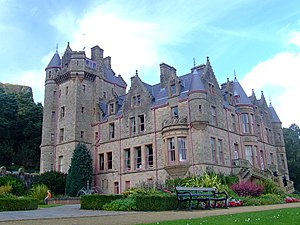
Name
The name Belfast is derived from the Irish Béal Feirsde, which was later spelled Béal Feirste.[11] The word béal means "mouth" while feirsde/feirste, the genitive singular of fearsaid, refers to a sandbar or tidal ford across a river's mouth.[12][13] The name would thus translate literally as "mouth of the sandbar" or "mouth of the ford".[12] The sandbar in question was formed at the confluence of two rivers at what is now Donegall Quay: the Lagan, which flows into Belfast Lough, and its tributary the Farset. The original settlement of Belfast is believed to have developed around this confluence of the Lagan and Farset.[14] The Irish name Béal Feirste is shared by a townland in County Mayo, whose name has been anglicised as Belfarsad.[15]
Origins
The site of Belfast has been occupied since the Bronze Age. The Giant's Ring, a 5,000-year-old henge, is located near the city, and the remains of Iron Age hill forts can still be seen in the surrounding hills.
Belfast remained a small settlement of little importance during the Middle Ages. John de Courcy built a castle on what is now Castle Street in the city centre in the 12th century, but this was a small affair than his Carrickfergus Castle to the north. The O'Neill clan had a presence in the area. In the 14th century, Clan Aedh Buidh, descendants of Hugh O'Neill built Grey Castle at Castlereagh, now in the east of the city.[16] Conn O'Neill also owned land in the area, one remaining memory of his presence being Conn's Water, a river flowing through east Belfast.[17]
Growth
Belfast became a substantial settlement in the 17th century after being established as a town by Sir Arthur Chichester. It was initially settled by Protestant English and Scottish migrants at the time of the Plantation of Ulster, for although Belfast and County Antrim did not form part of the Plantation scheme, they were the most heavily settled areas.
The Society of United Irishmen was founded in Belfast in 1791, after Henry Joy McCracken and other prominent Presbyterians from the city invited Wolfe Tone and Thomas Russell to a meeting, having read Tone's "Argument on Behalf of the Catholics of Ireland". This period of Belfast's growth can still be seen in the oldest areas of the city, known as the Entries.
Industrial Revolution
Belfast blossomed as a commercial and industrial centre in the 18th and 19th centuries and became Ireland's pre-eminent industrial city. Linen, rope-making, tobacco, heavy engineering and shipbuilding, all thrived at the end of the nineteenth century and Belfast briefly overtook Dublin as the largest city of the island, while the Harland and Wolff shipyards became one of the largest shipbuilders in the world, employing up to 35,000 workers.[18]
In 1920, Belfast became the capital of the new entity of Northern Ireland but was not spared the bloodshed of the war which left some 500 dead in Belfast, the bloodiest sectarian strife in the city until the "Troubles" of the late 1960s onwards.[19]
During the Second World War Belfast was heavily bombed. In one raid alone in 1941, German bombers killed around one thousand people and left tens of thousands homeless; the greatest loss of life in a night raid during the Blitz outside London.[20]
The Troubles
Belfast has been the capital of Northern Ireland since its establishment in 1921 following the Government of Ireland Act 1920. Since its emergence as a major city, it had been the scene of various episodes of sectarian conflict between its Roman Catholic and Protestant populations, which politically became known as "republican" and "loyalist" respectively, or "nationalist" and "unionist".
From around 1969 to the late 1990s this conflict flared into violence, known as "The Troubles".
Belfast saw some of the worst of the Troubles in Northern Ireland, particularly in the 1970s, as rival paramilitary groups formed on both sides. Bombings, assassinations and street violence formed a backdrop to life. On one day in 1972 the IRA detonated 22 bombs within the confines of Belfast city centre, on what is known as "Bloody Friday", killing nine people. The IRA also killed hundreds of other civilians and members of the security forces trying to keep the peace.
Loyalist paramilitaries for their part, including the Ulster Volunteer Force and the Ulster Defence Association claimed that the killings they carried out were in retaliation for the IRA campaign, though most of their victims were Roman Catholic civilians with no links to the IRA. A particularly notorious group, based on the Shankill Road in the mid 1970s, became known as the [Shankill Butchers.
In all, over 1,500 people were killed in political violence in the city from 1969 until 2001.[21]
Local government
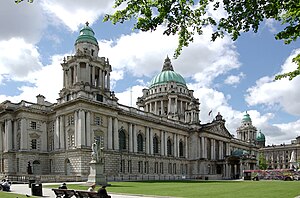
The City of Belfast has a mayoral form of municipal government. The city's officials are the Lord Mayor, Deputy Lord Mayor and High Sheriff, who are elected from among 51 councillors. The first Lord Mayor of Belfast was Daniel Dixon, who was elected in 1892.[22]
Arms and motto
The city of Belfast has the Latin motto Pro tanto quid retribuamus. This is taken from Psalm 116 Verse 12 in the Latin Vulgate Bible and is literally "For so much what we shall repay". The verse has been translated in different bibles differently – for example as "What shall I render unto the Lord for all his benefits toward me?".[23] It is also translated as "In return for so much, what shall we give back?" The Queen's University Students' Union Rag Week publication PTQ derives its name from the first three words of the motto.
The city's arms show a central shield, bearing a ship and a bell, supported by a chained wolf or wolfhound and a seahorse. The crest is also a seahorse, which crest dates back to 1613, when King James I granted Belfast town status. The seal was used by Belfast merchants throughout the seventeenth century on their signs and trade-coins.[24] A large stained glass window in the City Hall displays the seal, where an explanation suggests that the seahorse and the ship refer to Belfast's significant maritime history. The wolf may be a tribute to the city's founder, Sir Arthur Chichester, and refer to his own coat of arms.[24]
Culture
Belfast's population is evenly split between its Protestant and Roman Catholic residents, two distinct cultural communities. Since the end of the Troubles, Belfast has begun a social, economic and cultural transformation giving it a growing international cultural reputation.[25]
In 2004–05, art and cultural events in Belfast were attended by 1.8 million people (400,000 more than the previous year). The same year, 80,000 people participated in culture and arts activities, twice as many as in 2003–04.[26] A combination of relative peace, international investment and an active promotion of arts and culture is attracting more tourists to Belfast than ever before. In 2004–2005, 5.9 million people visited Belfast, a 10% increase from the previous year, and spent £262.5 million.[26]
The Ulster Orchestra, based in Belfast, is Northern Ireland's only full-time symphony orchestra and is well renowned in the United Kingdom. Founded in 1966, it has existed in its present form since 1981, when the BBC Northern Ireland Orchestra was disbanded.[27] The music school of Queen's University is responsible for arranging a notable series of lunchtime and evening concerts, often given by renowned musicians which are usually given in The Harty Room at the university (University Square).
There are many traditional Irish bands playing throughout the city and quite a few music schools concentrate on teaching Irish music.
References
- ↑ 2001 UK Census
- ↑ "Lagan Weir – Why it exists". Laganside. http://www.laganside.com/laganweir.asp. Retrieved 2007-05-25.
- ↑ "Belfast City: Did you know?". Discover Ireland. Tourism Ireland. 2007. http://www.discoverireland.com/za/ireland-places-to-go/areas-and-cities/belfast-city/highlights/culture/. Retrieved 2007-05-18.
- ↑ "Belfast Hills". Discover Northern Ireland. Northern Ireland Tourist Board. http://www.discovernorthernireland.com/product.aspx?ProductID=10391. Retrieved 2007-05-18.
- ↑ "About the Cave Hill". The Cave Hill Conservation Campaign. 2007. Archived from the original on February 6, 2007. http://web.archive.org/web/20070206154855/http://www.cavehill.freeuk.com/home.htm. Retrieved 2007-05-25.
- ↑ Margrethe C Lauber "Belfast's Peacelines: An Analysis of Urban Borders, Design and Social Space in a Divided City"
- ↑ "Exploring Belfast's cultural life". Belfast City Council. 2007. http://www.belfastcity.gov.uk/culture/culturallife.asp?menuitem=culturallife. Retrieved 2007-05-25.
- ↑ "Gaeltacht Quarter". Department of Culture, Arts and Leisure. 2007. http://www.dcalni.gov.uk/index/languages/gaeltacht_quarter.htm. Retrieved 2007-05-25.
- ↑ "The Golden Mile: Pub Crawl". Virtual Belfast. http://www.belfastbar.co.uk/The-Golden-Mile-articles.htm. Retrieved 2007-05-25.
- ↑ 10.0 10.1 "Corporate Message: The Vision". About Us at Titanic Quarter. Titanic Quarter. 2006. http://www.titanic-quarter.com/about.php?ID=3. Retrieved 2007-05-18.
- ↑ Dictionary of the Irish Language: bél (Letter B, Column 61); fertas (Letter F, Column 96).
- ↑ 12.0 12.1 "Placenames Database of Ireland – Belfast". Logainm.ie. http://www.logainm.ie/?text=Belfast&placeID=118005&uiLang=en. Retrieved 2010-08-12.
- ↑ "Placenames/Logainmneacha – Belfast". BBC Northern Ireland – Education. BBC. http://www.bbc.co.uk/northernireland/irish/blas/education/beginnersblas/1belfast.shtml. Retrieved 2007-05-17.
- ↑ Keenan, Desmond (2000). Pre-Famine Ireland. XLibris.com. Chapter 5. http://www.deskeenan.com/4PrChapter5.htm.
- ↑ Placenames Database of Ireland - Belfarsad
- ↑ Komesu, Okifumi (1990). Irish Writers and Politics. Rowman & Littlefield. p. 73. ISBN 9780389209263. http://books.google.com/?id=AwFO2Z8Bk0YC&pg=PA73&lpg=PA73&dq=%22yellow+hugh+o+neill%22.
- ↑ "Celebrations mark the arrival of first Ulster Scots in Ireland" (PDF). Irish News. 2006-04-24. http://www.theflightoftheearls.net/May2406.pdf. Retrieved 2007-09-18.
- ↑ "Cranes to remain on city skyline". BBC News. 2003-10-09. http://news.bbc.co.uk/1/hi/northern_ireland/3176184.stm. Retrieved 2007-03-12.
- ↑ Robert Lynch, The Northern IRA and the Early YEars of Partition, p227
- ↑ "The Belfast blitz is remembered". BBC News. 2001-04-11. http://news.bbc.co.uk/1/hi/northern_ireland/1269206.stm. Retrieved 2007-03-12.
- ↑ "Sutton Index of Deaths". CAIN. 2001-04-11. http://news.bbc.co.uk/1/hi/northern_ireland/1269206.stm. Retrieved 2007-09-10.
- ↑ "Councillors: Lord Mayor". Belfast City Council. http://www.belfastcity.gov.uk/councillors/index.asp?menuitem2=lord-mayor. Retrieved 2007-05-24.
- ↑ King James Bible, Psalm 116 Verse 12
- ↑ 24.0 24.1 Brett, C. E. B. (1967). Buildings of Belfast, 1700–1914. London: Weidenfeld and Nicolson.
- ↑ "Summary of the bid". One Belfast Where Hope and History Rhyme (Internet Archive). Imagine Belfast 2008. 2002-11-22. http://web.archive.org/web/20021207124752/www.imaginebelfast2008.com/front.html. Retrieved 2007-05-24.
- ↑ 26.0 26.1 "Integrated Cultural Strategy for Belfast" (PDF). Capital City: Belfast City Councils Development Agenda. 2006-05. http://www.belfastcity.gov.uk/culture/culturalstrategy.asp. Retrieved 2007-05-24.
- ↑ "Welcome to the new season". Ulster Orchestra Society. Archived from the original on February 5, 2007. http://web.archive.org/web/20070205212256/http://www.ulster-orchestra.org.uk/concerts/welcome.html. Retrieved 2007-05-24.